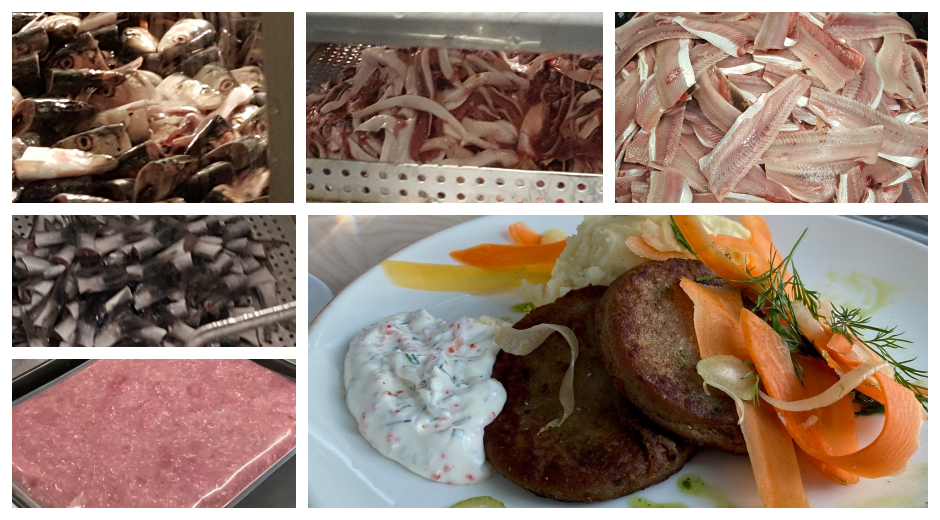When filleting pelagic fish, the common practice is to collect all off-cuts such as heads, tails and backbones in one bin. This immediately reduces the quality of the off-cuts as they become contaminated with e.g. blood, enzymes and residues from the intestines. Consequently, the use and value become limited, which is why the off-cuts typically are sold for feed production.
However, if handled correctly, there is great potential for using the off-cuts for more valuable purposes such as high-quality food ingredients for fish burgers as they are rich in proteins.
This requires a change in the existing logistics – a challenge, which the partners in the EU-funded project WaSeaBi have taken up by developing a new sorting technology that makes it possible to separate herring into head, backbones, viscera + belly flap, tail in addition to the fillet.

Successful implementation of sorting technology
The sorting technology has successfully been implemented at the herring processing company Sweden Pelagic AB in close cooperation with Chalmers University of Technology. And these new fractions can form the basis for development of new products at Sweden Pelagic.
“The sorting technology gives us a lot more possibilities to develop new healthy and tasty seafood. In the long run, we hope it will give us a better revenue,” says Martin Kuhlin, CEO of Sweden Pelagic AB, one of the industry partners. “I think that it will give us great advantages in the future. The technology will make it possible to extend our product range. This year, we estimate that we will produce around 200 – 300 tons of ‘herring mince’, and the ambition is to increase that number every year.”
In addition to the possibility of developing new products, increasing the revenue and extending the product range, Martin Kuhlin also thinks that via the sorting technology they will be able to market their products towards new consumer groups.
“In the first case, we will sell the products to the industrial customers, who manufacture pan-ready or eat-ready products. But we have experienced that also school kitchens and “public meal producers” have a great interest in the mince.”
From 1 to 5 different cuts of the fish
The new sorting technology has been developed by re-building a filleting line for pelagic fish, which now fractionates and separates the fish into 5 different clean parts. This means that Sweden Pelagic AB now has 5 cuts instead of one, which they can sell for subsequent production of food raw materials and ingredients such as minces, protein isolates, hydrolysates and oils.
And the sorting technology can also be applied to other fish species, however, Martin Kuhlin points to a challenge in the fish industry: “I really believe that we, in the fish industry, are way behind for example the meat industry. They have for a long time been very good at taking care of the whole animal in a much better way than ‘our’ industry.”
Ingrid Undeland, Professor of Food Science at the Department of Biology and Biological Engineering at Chalmers University of Technology, who has been working on the technology adds that “It is of course important that the off-cuts are handled just as carefully as the main product i.e. the fillet, where focus is on preserving the quality throughout the whole value chain. Thus, instead of seeing the off-cuts as side-streams or by-products, which indicates that they are “leftovers”, they should be seen as just another cut of the fish - just like in the meat industry.”
In the study, Lipid oxidation in sorted herring (Clupea harengus) filleting co-products from two seasons and its relationship to composition, which was published with open access in Food Chemistry, you can read about the five sorted herring fractions’ susceptibility to lipid oxidation during ice storage. One of the conclusions from the study is that sorting herring filleting co-products to reach a broadened food production from this species, going beyond just the classic fillet, is advantageous to avoid that the most pro-oxidant-rich parts “contaminate” the more stable ones.
Notes
Facts about the fish processing industry
In the EU the fish processing industry is a significant industry that generates an overall turnover of nearly €28 billion and employs more than 122,000 people. However, the industry is facing several challenges. For instance, it is estimated that the amount of seafood side-streams in Europe is about 1.5 million tons based on a production of 5.1 million tons of fish caught. This means that the current utilization of the aquatic biomass is much too low. Up to 70 % of the aquatic resources end up as side-streams, which are either used for low-value purposes such as animal feed or disposed of, which is costly for the companies involved
More about the WaSeaBi project
WaSeaBi is a four-year project that aims to optimise the utilisation of seafood side-streams by developing new methods to produce nutritious and tasty ingredients. The project brings together an interdisciplinary team of 13 partners from five European nations which include Technical University of Denmark, Food & Bio Cluster Denmark, Chalmers University of Technology, AZTI, EIT Food, Sweden Pelagic, Royal Greenland, Alfa Laval, Pescados Marcelino, Jeka Fish, Barna, Nutrition Sciences, Ghent University.
The project receives funding from the Bio Based Industries Joint Undertaking (JU) under the European Union’s Horizon 2020 research and innovation programme under grant agreement No 837726. The JU receives support from the European Union’s Horizon 2020 research and innovation programme and the Bio Based Industries Consortium.














